15 ways to open Device Manager in Windows 10
Device Manager is a useful tool that allows you to do things like: find unknown hardware devices, update drivers, disable hardware components from inside the computer, etc.
To use it, you must first know how to open this tool.
1. Open Device Manager using Windows 10 Search
One of the fastest ways to run Device Manager in Windows 10 is to use the search box near the Start button. In there, type "device" or "device manager" and click or tap the appropriate search result.
2. Start Device Manager using Command Prompt (CMD) or PowerShell
If you prefer the command line environment, first open Command Prompt (also known as CMD) or PowerShell. Then, in the PowerShell or Command Prompt window, enter one of these three commands and press Enter: devmgmt.msc, mmc devmgmt.msc or control hdwwiz.cpl .
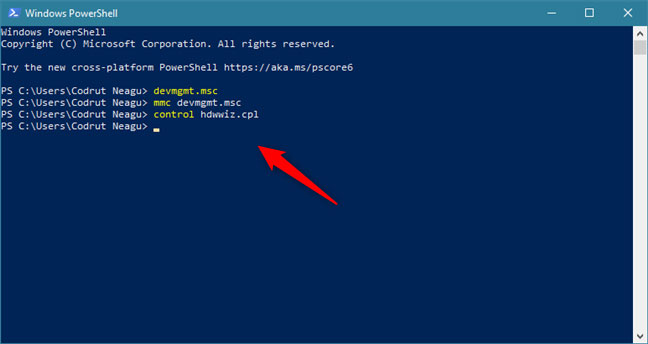
All of these Device Manager commands work the same.
3. Launch Device Manager using the Run command
Open the Run window (press Win+ Ron the keyboard at the same time), then enter one of the following three commands in the Open field : devmgmt.msc, mmc devmgmt.msc or control hdwwiz.cpl .
Tap Enteror click or tap OK , and Device Manager will open immediately.
4. Open Device Manager using the WinX menu
Open the WinX menu by simultaneously pressing the Win+ keys Xon the keyboard. Alternatively, you can also right-click the Start button to get the same result. Then, click or tap the Device Manager shortcut.

5. Run Device Manager from the Devices and Printers section of Control Panel
If you like the old-fashioned Control Panel, open it and navigate to the Hardware and Sound settings category . Then, click on the Device Manager link found under Devices and Printers .
6. Open Device Manager from Control Panel using icon view
There is also another method to access Device Manager using Control Panel. After you open Control Panel, click View by Category in the upper right corner.
In the menu that opens, select Large icons or Small icons, depending on what you like.
You will be shown a list of shortcuts and one of them is Device Manager . Click on it.
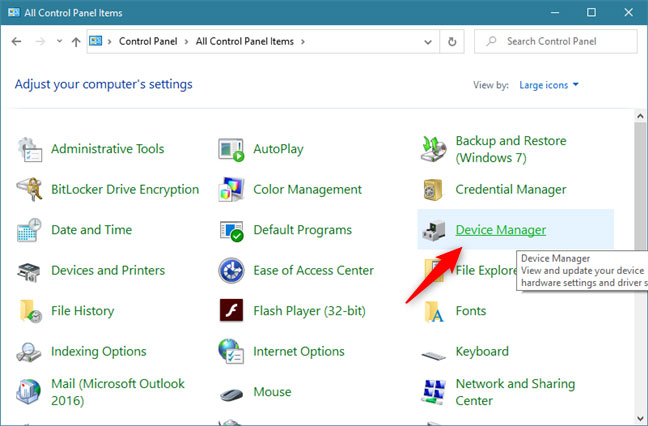
7. Open Device Manager from Computer Management
You can access Device Manager from within another Windows 10 tool, called Computer Management . Open Computer Management and in the navigation panel on the left, select Computer Management > System Tools > Device Manager .
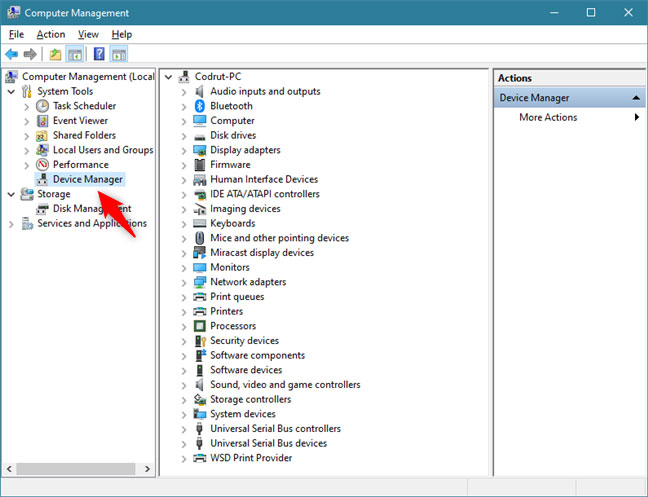
8. Launch Device Manager using Cortana
If you have Cortana enabled, you can ask the virtual assistant to open Device Manager directly for you. Click this tool's button from the taskbar or say " Hey Cortana ", then use your voice to request " Open Device Manager ".
9. Open Device Manager from This PC
The final method is to use This PC. Open File Explorer and on the navigation panel from the left, right-click (or press and hold) on This PC . Then, click Manage in the context menu that appears.
That action will open Computer Management. All you have to do next is select Device Manager on the left side of the window.
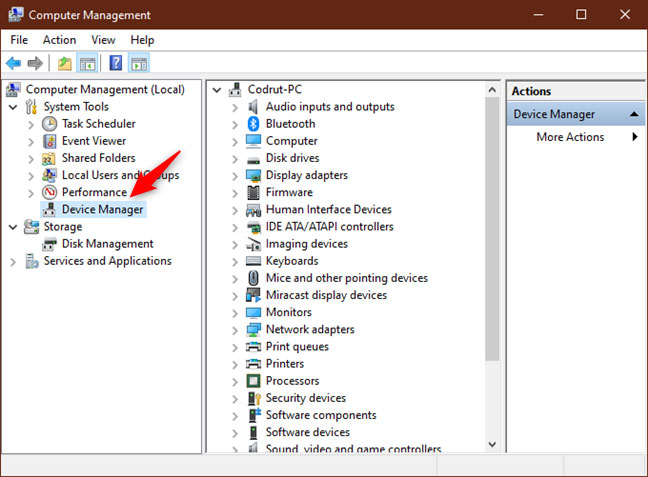
10. Use Quick Access Menu
Quick Access Menu can also help you access Device Manager easily. Here's how you can use this feature:
- Press Win + X or right-click the Windows icon to open Quick Access Menu .
- Select Device Manager from the menu items.
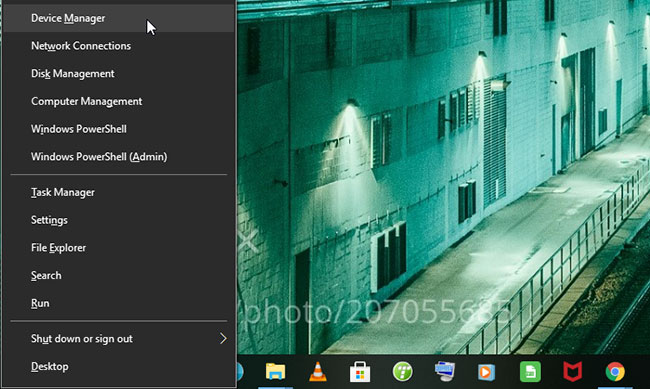
11. Use File Explorer's address bar
You can access countless Windows applications via File Explorer's address bar. Here's how you can use this feature to open Device Manager:
- Press Win + E to open File Explorer.
- Enter devmgmt.msc in the address bar and press Enter to open Device Manager.
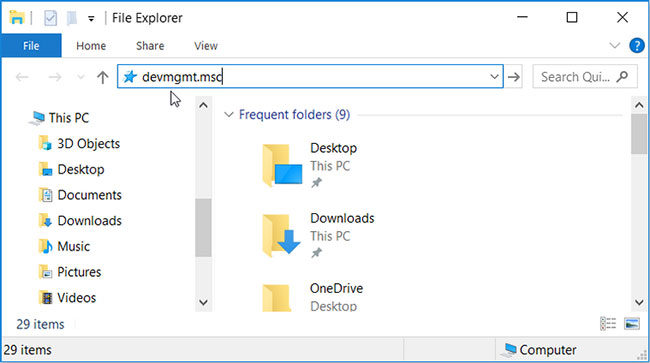
12. Use Task Manager
Task Manager helps you analyze processes and system performance. It also helps you put an end to applications that slow down your PC. What's interesting is that this tool can also help you access some Windows applications easily.
Here's how you can access Device Manager using Task Manager:
- Press Ctrl + Shift + Esc to open Task Manager.
- Click the File tab in the upper left corner and select Run new task .
- Enter devmgmt.msc in the search box and click OK to open Device Manager.
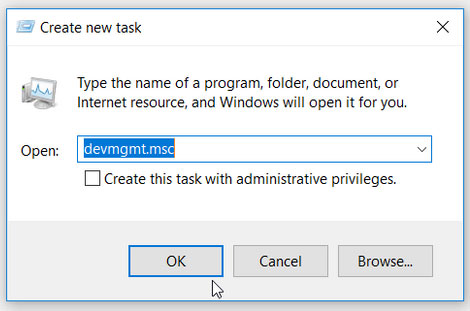
13. Use System Settings
System Settings are not only useful when you want to fix problems on your Windows device. You can also use the settings window to launch various software programs.
Here's how you can open Device Manager with system settings:
- Press Win + I to open system settings.
- Type Device Manager in the search box and tap on the relevant option that appears.
14. Go through the System32 folder
You can also access Device Manager by navigating to a relevant path in Local Disk (C:) . Let's see how you can do this:
- Type This PC in the Start menu search bar and select the most relevant result.
- Click Local Disk (C:) on the right side and navigate to Windows > > en-US .
- Scroll down and click on devmgmt option to launch Device Manager.
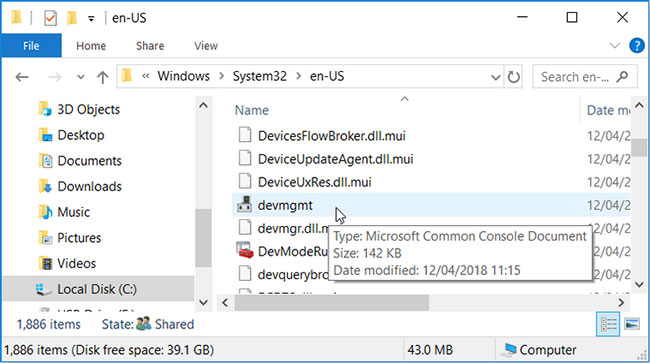
15. Create a desktop shortcut for Device Manager
You can always access most Windows applications with desktop shortcuts. All you need to do is create these application shortcuts and pin them to the taskbar for easy access.
Let's see how you can create a desktop shortcut for Device Manager:
Step 1 : Press Win + D to access the desktop.
Step 2 : Right-click an empty space on the desktop and navigate to New > Shortcut .
Step 3 : Enter %windir%system32devmgmt in the location box and click Next to continue.
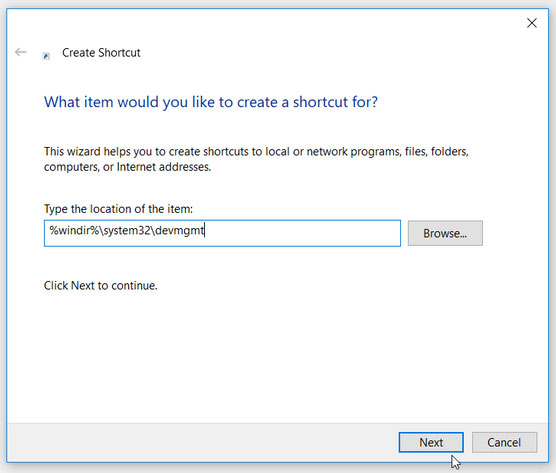
In the next window, enter Device Manager or choose any other suitable name for the shortcut you just created, then click Finish.
Now, you can pin the Device Manager shortcut to the taskbar for easy access. To do this, right-click on the shortcut and select Pin to taskbar . From now on, you will be able to quickly access the Device Manager tool by clicking its shortcut on the taskbar.
Device Manager comes in handy when you encounter various hardware-related problems. It provides an easy way to manage Bluetooth devices, keyboards, USB devices, etc. If you want to easily access this feature, just check out the tips mentioned in the article.
You should read it
- 9 ways to open Device Manager in Windows 10
- How to use Device Manager to troubleshoot Windows 10
- How to Open Device Manager in Windows
- Steps to open Device Manager on Windows
- Quickly download new drivers through Device Manager on Windows 10
- How to find lost Android devices using Android Device Manager
- All problems about using Task Manager
- 6 ways to fix Bluetooth errors not in Device Manager on Windows 10, 8.1, 8, 7, XP, Vista
May be interested
- 7 fastest ways to open Task Manager on Windows
 task manager helps you to kill frozen applications and check cpu, ram on windows. if you can't open it in the usual way, try shortcuts, cmd or run for quick access.
task manager helps you to kill frozen applications and check cpu, ram on windows. if you can't open it in the usual way, try shortcuts, cmd or run for quick access. - What is Windows Device Manager? How to use it?
 windows device manager is an important tool in the windows operating system, listing all the list of hardware devices recognized by windows, including problems with unrecognized device drivers.
windows device manager is an important tool in the windows operating system, listing all the list of hardware devices recognized by windows, including problems with unrecognized device drivers. - 6 ways to fix Bluetooth errors not in Device Manager on Windows 10, 8.1, 8, 7, XP, Vista
 cannot connect a bluetooth device to a computer? bluetooth keyboard, mouse, microphone, headset or other wireless devices are not recognized in windows computers, this is a bluethooth error not available in device manager on windows. therefore, this article will introduce you to 6 ways to fix this bluetooth error on windows.
cannot connect a bluetooth device to a computer? bluetooth keyboard, mouse, microphone, headset or other wireless devices are not recognized in windows computers, this is a bluethooth error not available in device manager on windows. therefore, this article will introduce you to 6 ways to fix this bluetooth error on windows. - How to use Device Manager to troubleshoot Windows 10
 in this short guide, tipsmake will help you learn how to use device manager to troubleshoot windows 10 problems.
in this short guide, tipsmake will help you learn how to use device manager to troubleshoot windows 10 problems. - Device Association Framework Provider What is a Host and why is it running on a computer?
 every time you open task manager on a windows 8 or windows 10 computer, you will see a lot of processes called 'device association framework provider host' running. what is 'device association framework provider host'? and why this process is running on your windows computer. is this a virus? all answers will be in the following article of network administrator.
every time you open task manager on a windows 8 or windows 10 computer, you will see a lot of processes called 'device association framework provider host' running. what is 'device association framework provider host'? and why this process is running on your windows computer. is this a virus? all answers will be in the following article of network administrator. - How to open Task Manager, introduce the functions in Task Manager
 how to open task manager, introduce the functions in task manager. true to its name, task manager is a tool that helps us manage all the active tasks in windows. however, task manager not only has that feature, it also has children
how to open task manager, introduce the functions in task manager. true to its name, task manager is a tool that helps us manage all the active tasks in windows. however, task manager not only has that feature, it also has children - How to keep Windows Task Manager open a specific tab
 while using task manager to monitor your windows 10 pc, you sometimes use one tab (e.g. 'performance') more often than others. in that case, you can set that tab as the one you see when you start task manager.
while using task manager to monitor your windows 10 pc, you sometimes use one tab (e.g. 'performance') more often than others. in that case, you can set that tab as the one you see when you start task manager. - Quickly download new drivers through Device Manager on Windows 10
 on windows 10, drivers are needed for your device to connect with other devices and the operating system. windows 10 provides a series of default generic drivers for monitors (displays), wireless connections such as bluetooth, keyboards, mice, and other manufacturer-installed hardware.
on windows 10, drivers are needed for your device to connect with other devices and the operating system. windows 10 provides a series of default generic drivers for monitors (displays), wireless connections such as bluetooth, keyboards, mice, and other manufacturer-installed hardware. - How to find lost Android devices using Android Device Manager
 android device manager is an android device management application that helps you locate your smartphone if lost.
android device manager is an android device management application that helps you locate your smartphone if lost. - 3 ways to open Windows Services on Windows 10, 8, 7
 want to enable/disable system services but don't know how to open windows services? check out 3 quick ways to do it using run, cmd, and task manager.
want to enable/disable system services but don't know how to open windows services? check out 3 quick ways to do it using run, cmd, and task manager.










 Portrait of Steve Ballmer, his former assistant who is richer than Bill Gates
Portrait of Steve Ballmer, his former assistant who is richer than Bill Gates The fastest way to turn off the screen in Windows
The fastest way to turn off the screen in Windows Basic Linux commands everyone needs to know - Operations on Linux are much faster
Basic Linux commands everyone needs to know - Operations on Linux are much faster How to fix error 0x80070422 in Windows 10, fix error 0x80070422 update Windows
How to fix error 0x80070422 in Windows 10, fix error 0x80070422 update Windows How to get admin rights on Windows
How to get admin rights on Windows What is Pentest? Learn about Penetration Testing (penetration testing)
What is Pentest? Learn about Penetration Testing (penetration testing)